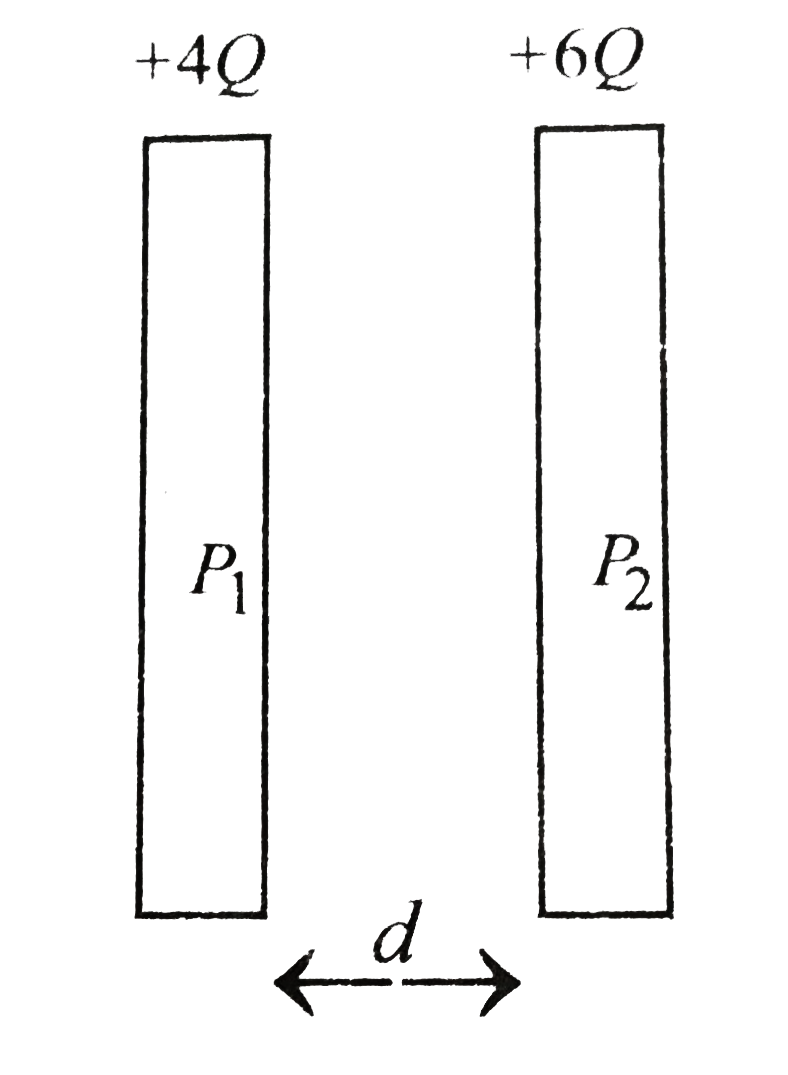Two identical conducting balls A and B have charges- Q and + 3Q respectively. They are brought in contact with each other and then separated by a distance d part. Find the nature of the Coulomb force between them.
To solve the problem step by step, we will analyze the charges on the balls before and after they are brought into contact, and then determine the nature of the Coulomb force between them.
Step 1: Identify Initial Charges
- Ball A has a charge of −Q.
- Ball B has a charge of +3Q.
Step 2: Calculate Total Charge When Contacted
When the two balls are brought into contact, the total charge is the sum of their individual charges:
Qtotal=−Q+3Q=2Q
Step 3: Distribute Charge Equally
Since the balls are identical and conducting, they will share the total charge equally when they are in contact. Therefore, the charge on each ball after contact will be:
Qeach=Qtotal2=2Q2=Q
Step 4: Determine Charges After Separation
After separating the balls, Ball A will have a charge of Q and Ball B will also have a charge of Q.
Step 5: Analyze the Nature of the Coulomb Force
Now that both balls have the same charge Q, we can determine the nature of the Coulomb force between them. According to Coulomb's law:
- Like charges repel each other.
Since both balls have the same charge Q, they will repel each other.
Conclusion
The nature of the Coulomb force between the two balls after they are separated is repulsive.
---
- Ball A has a charge of −Q.
- Ball B has a charge of +3Q.
When the two balls are brought into contact, the total charge is the sum of their individual charges:
Qtotal=−Q+3Q=2Q
Since the balls are identical and conducting, they will share the total charge equally when they are in contact. Therefore, the charge on each ball after contact will be:
Qeach=Qtotal2=2Q2=Q
After separating the balls, Ball A will have a charge of Q and Ball B will also have a charge of Q.
Now that both balls have the same charge Q, we can determine the nature of the Coulomb force between them. According to Coulomb's law:
- Like charges repel each other.
The nature of the Coulomb force between the two balls after they are separated is repulsive.
Topper's Solved these Questions
Similar Questions
Two identical conducting balls A and B have charges -Q and +3Q respectively . They are brought in contact with each other and then separated by a distance d apart. Find the nature of the coulumb force between them.
View SolutionA charged metallic sphere A having charge qA is brought in contact with an uncharged metallic sphere of same radius and then separated by a distance d. What is the electrostatic force between them
View Solution
Knowledge Check
- Question 1 - Select One
Two conducting spheres of radii r1 and r2 having charges Q1 and Q2 respectively are connected to each other. There is
Ano change in the energy of the systemBan increase in the energy of the systemCalways a decrease in the energy of the systemDa decrease in the energy of the system unless Q1r2=Q2r1 - Question 2 - Select One
Three identical conducting spheres A, B and C are given charges +Q, +q and -2Q respectively. A and C are brought in to contact and separated. Next B and C are brought in to contact and separated. If A,B and C are arranged so that their centres form an equilateral triangle and they do not touch each wihich of the following statement is correct regarding the forces between the pairs
(A,B),(B,C), and (C,A)?A(A,B) atrract, (B,C) attract, (C,A) repelB(A,B) attract, (B,C) repel, (C,A) repelC(A,B) atrract, (B,C) repel, (C,A) attractD(A,B) repel, (B,c) attract, (C,A) repel - Question 3 - Select One
Two identical small conducting spheres having unequal positive charges q1 and q2 are separated by a distance r. If they are now made to touch each other and then separated again to the same distance, the electrostatic force between them in this case will be
Aless than beforeBsame as beforeCmore than beforeDzero
Two small conducting spheres have charges 2.1nC and −0.1nCare touched to each other and then separated by a distance of 0.5 m. Find the force between them
View SolutionTwo identical small conducting balls have positive charges q1 and q2 respectively. The force between the balls when they are placed at a separation is F. The balls are brought together so that they touch and then put back in their original positions. Prove that the force between the balls now, cannot be less than F.
View SolutionTwo unlike charges of magnitude q are separated by a distance 2d. The potential at a point midway between them is
View SolutionTwo identical conducting very large plates P1andP2 having charges +4Qand+6Q are placed very closed to each other at separation d. The plate area of either face of the plate is A. The potential difference between plates P1andP2 is
 View Solution
View SolutionTwo identical metal plates are given poistive charges Q1 and Q2 (<Q1) respectively. If they are now brought close together to form a parallel plate capacitor with capacitance C, the potencial difference between them is
View Solution

